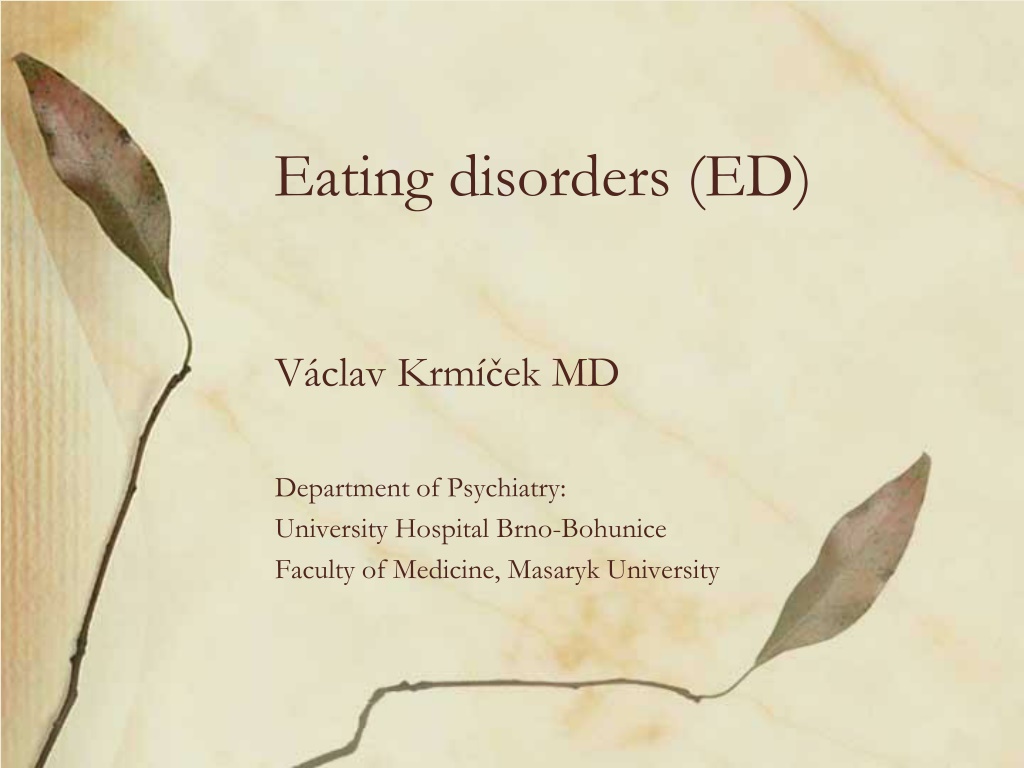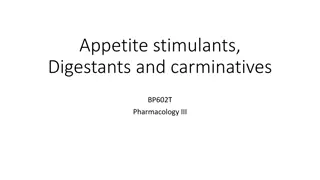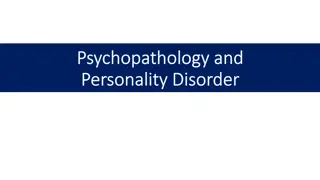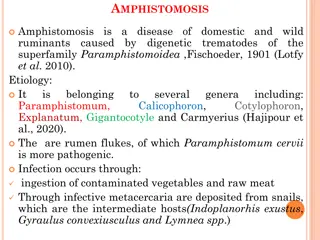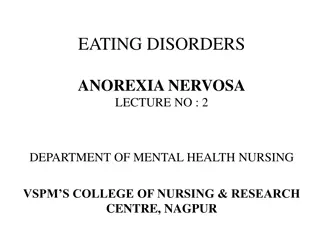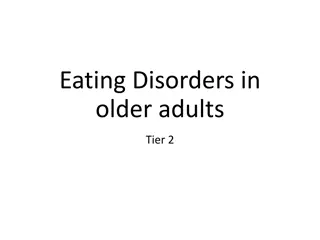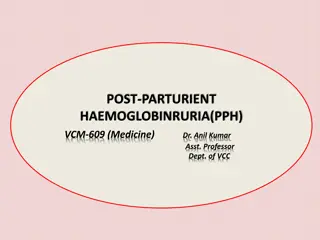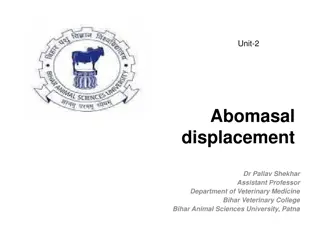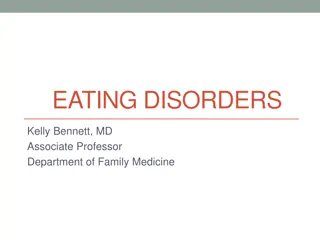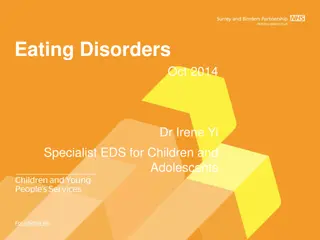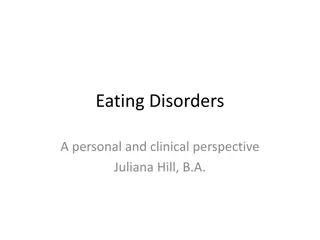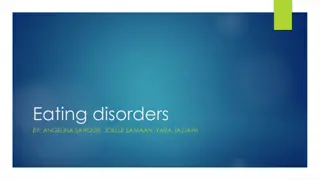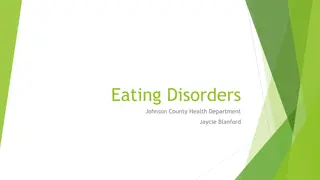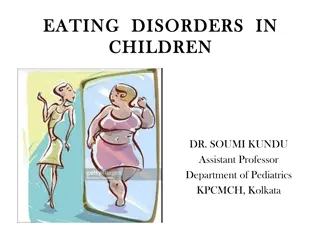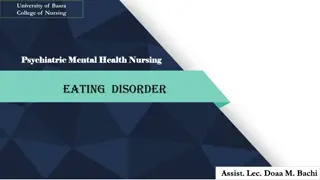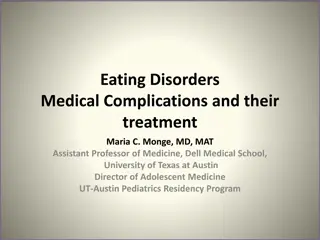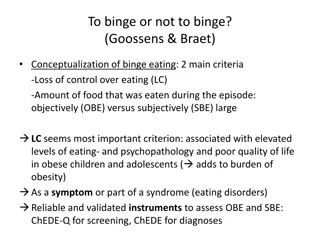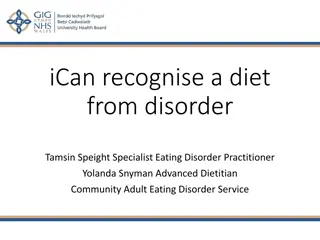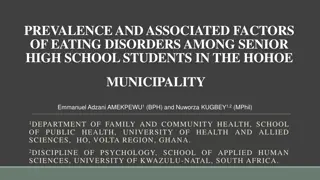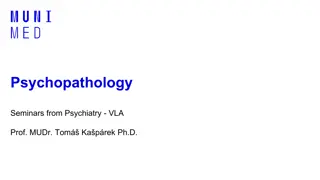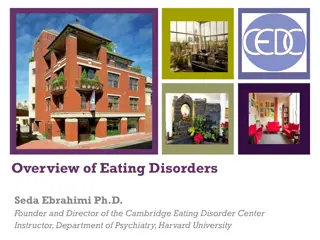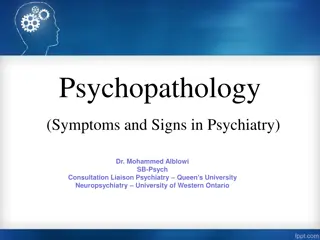Understanding Anorexia Nervosa: Symptoms and Psychopathology
Anorexia nervosa is a serious eating disorder characterized by food restriction, bingeing, purging, and distorted body image. Common symptoms include excessive exercise, body checking, and rigid food rules. Psychopathology aspects include intrusive dread of fatness, self-imposed low weight threshold, and mood fluctuations. Denial of symptoms and manipulation of others are also common behaviors. ICD-10 criteria involve BMI <17.5, self-induced weight loss, and excessive exercise.
Download Presentation

Please find below an Image/Link to download the presentation.
The content on the website is provided AS IS for your information and personal use only. It may not be sold, licensed, or shared on other websites without obtaining consent from the author. Download presentation by click this link. If you encounter any issues during the download, it is possible that the publisher has removed the file from their server.
E N D
Presentation Transcript
Eating disorders (ED) V clav Krm ek MD Department of Psychiatry: University Hospital Brno-Bohunice Faculty of Medicine, Masaryk University
Classification of ED Anorexia nervosa (AN) Bulimia nervosa (BN) Atypical AN or BN Binge eating disorder
Anorexie nervosa - behaviour Restricting type: food restriction (dieting, shrinking portions, periods of starvation) Binge-eating/purging type: alternation of periods with food restriction and periods of overeating followed by self-induced vomiting, abuse of laxatives, appetite suppressants and diuretics
Anorexia nervosa - behaviour Common symptoms excessive exercise body checking mirror gazing, repaeted weighing or avoidance the mirror and refusal to weigh increased preoccupation with food strict rules regarding food intake counting the caloric value of foods eating at precise time intervals cooking for household members
Anorexia nervosa - psychopathology Intrusive dread of fatness and weight gain even during severe malnutrition leads to a self-imposed low weight threshold remorse after eating Body image disturbance overestimation of weight and body shape particularly the buttocks, abdomen and thighs
Anorexia nervosa - psychopathology Fluctuations of mood reduction of social contacts disrupted concentration Deny the severity of symptoms they tend to lie and manipulate other people
Anorexia nervosa ICD-10 criterions Body weight decreases in BMI <17.5 Self-induced weight loss food restriction (restricting type) self-induced vomiting, abuse of laxatives, appetite suppressants and diuretics (binge-eating/purging type) excessive exercise
Anorexia nervosa ICD-10 criterions Psychopathology intrusive dread of fatness body image disturbance negative emotional evaluation of their body self-imposed low weight threshold
Anorexia nervosa ICD-10 criterions Primary or secondary amenorrhea usually not present when using hormonal contraceptives Delay or absence of pubertal symptoms Changes in hormone level kortisol secondary hypothyroidism
Anorexia nervosa - epidemiology Lifetime prevalence for women it is about 0.5-2% for men 0.3% Just are observed by specialists Beginning between 12 and 15 years 1. hospitalizazion between 15 and 19 years rarely from 8 year
Anorexia nervosa personality Perfectionism low selfesteem performance orientation Neurotic and introversion personality anxious, inner insecure Dissatisfaction with one's body
Anorexia nervosa risk factors Family constelation predominant and hyperprotective mother emotional distant and passive father Lingering problems in the family divorce performance pressure competition with sibling for attention
Anorexia nervosa - course 1 or a few episodes with healing complete remision 19% More episodes during long period of life partial remision 60% Chronic course with any remision persistent illness 21% Mortality > 10%
Anorexia nervosa - comorbidities Depressive syndrom symptom of malnutrition Anxiety disorders Obsedant compulsive disorder intrusive thought of body shape, food urge to exercise, vomit
Health complications general I Absence of sensations hunger, satiety, fatigue insensitive about pain Oedema from hypoproteinemia
Health complications general II Deceleration or stopping of growth hormonal stimulation after restoration of weight Cortical atrophy deteoriation of cognition and emotions infantile behaviour
Dermal complications Acrocyanosis cold and violet hands and foots Hair loss Lanugo hair fine pale hair back, forearm Dry skinn Fragile nails
Cardiovascular complications Bradycardia by 94% of patients 50% under 40 beats per minute to 28 beats per minute decreased response to exercice Postural hypotension Risk of malignant arrhythmia cause of 1/3 death
Gastrointestinal complications Hypomotility slow gastric empthying (tension of stomach) constipation and flatulence correction of motility over 2 weeks of regular eating Salivary gland hypertrophy from vomitting or persistnat feel of hunger
Hormonal dysregulation Amenorhea, infertility Secondary hypothyroidism tyroxin (T4) a T3 normal level of TSH Osteoporosis neuroendocrine inhibition of blastogenesis kortisol 50% on densitometry
Maternity complications Perinatal problems higher perinatal mortality more ofen anxiety and depression symtoms relationship problems with newborns Assisted reproduction 1/3 client with eating disorder don t admit desease
Differential diagnosis of anorexia nervosa GIT deseases esofagitis, gastritis, gastric ulcer inflammatory bowel disease (Crohn's desease, ulcerative colitis) celiac desease, food intolerance Tumour Hyperthyroidism
Treatment of anorexia nervosa Ambulatory general practitioner psychological care psychiatric care nutritive consultant Hospitalization malnutrition (under 15 BMI) somatic complications (collapse) failure of ambulatory care
Treatment during hospitalization Regime therapy food 5-6x a day weekend permit only in a case of weight gain Psychotherapy individual, group or family (by children) Drug therapy Ergotherapy
Anorexia mentalis - drug therapy Antidepressants SSRI, mirtazapin, trazodon anxiety and depressive disorders, OCD Anxiolytics reduction of fear from wight gain and remorse after eating Antipsychotics olanzapin: massive anxiety, excessive exercise sulpirid: stomach ache after eating
Anorexia nervosa - psychotherapy Individual admit the severity of illnes attitude to the body and food personality and interpersonal problems Group Family separation, competition with sibling Education patient and relatives
Complications of psychotherapy Effort to maintain the disease feeling of uniqueness take self-confidence need of attention (rivarly, divorce) Formal cooperation ambivalnce to treatment and change often change their attitude they refer what we anticipate not that they realy mean
Bulimia nervosa - behaviour Typically daily starvation with evening episodes of overeating of large amount of food followed by self-induced vomiting
Bulimia nervosa - psychopathology Intrusive dread of fatness and weight gain leades to a self-imposed low weight threshold Strong desire to eat Depressive moods and remorse after episodes of overeating
Bulimia nervosa - somatic No significant malnutrition even overweight can occur weight fluctuations are greater than in anorexia nervosa
Bulimia nervosa ICD-10 criteria An intrusive dread of fatness Permanently busy of the food strong desire to eat episodes of overeating of large amount food Effort to suppress nutritious effect self-induced vomiting daily starvation abuse of laxatives, appetite suppressants or diuretics, excessive exercise
Bulimia nervosa - epidemiology Lifetime prevalence for women it is about 1.5-2,5% for men 0.2% Just 1/8 s recognise by general practitioner Beginning between 16 and 25 years
Bulimia nervosa - personality Impulsive behaviour without consideration feeling of lower self-control reduction of uncomfortable feelings Inclination depressive disorder, unstable mood drug abuse, promiscuity self-harm behaviour, suicide attempt
Health complications Mineral imbalance tetania, epileptoform seizures, arrhythmia complication of excessive vomiting abuse of diuretics or overdrinking Due to frequent vomiting tooth erosion esophagitis
Bulimia nervosa - treatment Don t search professional help often come for depression after suicide attempts Psychotherapy better motivation and cooperation than by anorexia nervosa
Bulimia nervosa drug treatment Antidepressants SSRI: fluoxetin 60mg/day heigher dosage than by depressive disorder Effect comorbidities depression, anxiety heal itself disease reduce frequency of bulimic episodes
Binge eating disorder - behaviour Episodes of overeating of large amount of food Absence of compensatory behaviour patients do not vomit do not exercise do not starve due to dissatisfaction with their body, however, they may unsuccessfully diet
Binge eating disorder - psychopathology Permanently busy of the food strong desire to eat Feeling of loss of control over food intake reduction of uncomfortable feelings maladaptive treating of stressful situations
Binge eating disorder somatic and comorbidites Overweight or even morbid obesity Depressive and axiety disorders
Binge eating disorder treatment Psychotherapy Lifestyle changes diet exercise Bariatric surgical interventions
Eating disorders by diabetes mellitus 2x higher risk of eating diorder by DM I Manifest by noncompliance in healing of diabetes diabulimia : reduce of dosage of insulin weight depletion despite enough intake of food inexplicable hypergylkemia polyuria binge eating diorder: 10-20x more frequent
